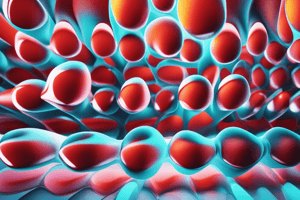Podcast
Questions and Answers
What is the potential danger sign for threatened abortion?
What is the potential danger sign for threatened abortion?
- Complete expulsion of uterine content
- Moderate cramping with light to moderate bleeding (correct)
- Fetus dies in utero but is not expelled
- Mouth severe bleeding with dilated cervix
What is the type of pregnancy where the fertilized ovum implants in the fallopian tube instead of the uterus?
What is the type of pregnancy where the fertilized ovum implants in the fallopian tube instead of the uterus?
- Placenta previa
- Ectopic pregnancy (correct)
- Abruptio placentae
- Uterine rupture
What are the potential symptoms of placenta previa?
What are the potential symptoms of placenta previa?
- Complete expulsion of uterine content, closed cervix
- Painless bright red vaginal bleeding, soft and non-tender uterus (correct)
- Fetus dies in utero but is not expelled
- Moderate cramping with mouth severe bleeding
What is the risk factor for abruptio placentae?
What is the risk factor for abruptio placentae?
What are the potential complications of uterine rupture?
What are the potential complications of uterine rupture?
What are the potential risks associated with amniotic fluid embolism?
What are the potential risks associated with amniotic fluid embolism?
What are the symptoms of cord prolapse?
What are the symptoms of cord prolapse?
What is the potential complication of placental insufficiency?
What is the potential complication of placental insufficiency?
What are the potential complications of gestational diabetes?
What are the potential complications of gestational diabetes?
What is a symptom of preterm labor?
What is a symptom of preterm labor?
What is a potential complication of postpartum depression?
What is a potential complication of postpartum depression?
Study Notes
- Complications of pregnancy: danger signs, bleeding disorders, and abnormal implantation of fertilized ovum
- Bleeding during pregnancy: types, risk factors, signs and symptoms, diagnostic tests, and treatments
- Spontaneous abortions: occurrence, risk factors, types, and treatment
- Threatened abortion: potential cramping with light to moderate bleeding, cervix remains closed
- Inevitable abortion: moderate cramping, mouth severe bleeding, cervix begins to dilate
- Incomplete abortion: woman has an abortion but not completely, risk for infection
- Complete abortion: complete expulsion of uterine content, cervix is closed
- Missed abortion: woman may experience no cramps, fetus dies in utero but is not expelled
- Reoccurring abortion: habitual abortion caused by incompetent cervix or progesterone levels being inadequate to maintain pregnancy
- Therapeutic abortion: intentional termination of pregnancy to preserve the health of the mother
- Ectopic pregnancy: fertilized ovum implants in the fallopian tube instead of the uterus, risk factors, symptoms, and diagnostic tests
- Placenta previa: placenta implants near or over the cervix, types, risks, and complications
- Placenta previa symptoms: painless bright red vaginal bleeding, uterus soft and non-tender, fetus can be in any position, reassuring fetal heart rate
- Placenta previa complications: placenta detaches from the uterine wall, cutting off blood supply to the baby, potentially causing baby's death and maternal complications
- Abruptio placentae: ties with placenta detaches from the uterine wall, risk factors, symptoms, and complications
- Abruptio placentae complications: maternal hemorrhage, fetal distress, and potential maternal death
- Uterine rupture: complete tear of the uterine wall, risk factors, symptoms, and complications
- Uterine rupture complications: maternal and fetal death, severe maternal injuries and lifelong complications
- Amniotic fluid embolism: amniotic fluid enters the maternal bloodstream, symptoms, risks, and complications
- Amniotic fluid embolism complications: shock, cardiac arrest, and maternal and fetal death
- Cord prolapse: umbilical cord comes out of the vagina before the baby, risk factors, symptoms, and complications
- Cord prolapse complications: fetal distress, maternal infection, and fetal and maternal death
- Placental insufficiency: placenta fails to function, symptoms, risks, and complications
- Placental insufficiency complications: fetal growth restriction, low birth weight, and fetal and maternal death
- Fetal growth restriction: baby does not grow properly in the womb, causes, symptoms, and complications
- Fetal growth restriction complications: developmental delays, lifelong health issues, and death
- Gestational diabetes: inadequate insulin to move glucose from the body into the body cells, symptoms, risks, and complications
- Gestational diabetes complications: macrosomia, hypoglycemia, and birth injuries
- Preeclampsia: pregnancy complication characterized by high blood pressure and damage to organs such as the liver and kidneys, symptoms, risks, and complications
- Preeclampsia complications: maternal and fetal death, premature birth, and long-term health issues
- Preterm labor: labor that begins before 37 weeks of pregnancy, symptoms, risks, and treatments
- Preterm labor treatments: tocolytics, bed rest, and corticosteroids
- Eclampsia: seizures during pregnancy, symptoms, risks, and complications
- Eclampsia complications: maternal and fetal death, brain damage, and long-term health issues
- Hemorrhage: excessive bleeding during or after childbirth, symptoms, risks, and treatments
- Hemorrhage treatments: fluids, blood transfusions, and medications
- Cesarean section: surgical delivery of a baby, risks, benefits, and complications
- Cesarean section complications: infection, hemorrhage, and organ damage
- Postpartum depression: depression after giving birth, symptoms, risks, and treatments
- Postpartum depression treatments: therapy, medication, and support groups.- Pregnancy care involves monitoring various aspects of a woman's health and that of the fetus
- Nursing care includes assessing level of consciousness, monitoring pulse oximeter, urine output, daily weights, and blood pressure
- Women with a history of early onset preeclampsia may be given low-dose aspirin therapy
- Hydralazine is a vasodilator used for severe preeclampsia, but its use requires caution due to potential decreased placenta perfusion
- Methyl dopa is an antihypertensive drug used to help lower blood pressure and prevent seizures
- Labetalol is another antihypertensive drug given to control hypertension rapidly
- Magnesium sulfate is used to prevent maternal seizures and lower blood pressure, but care must be taken to maintain therapeutic levels
- Signs of magnesium sulfate toxicity include decreased reflexes, decreased respirations, and decreased urine output
- Nifedipine is a calcium channel blocker used to control hypertension and increase urine output
- Anticonvulsant medications like magnesium sulfate are given to prevent seizures and maintain therapeutic levels to avoid toxicity.
- In case of seizure, maintain open airway, administer oxygen, and monitor fetal heart rate while controlling seizures
- Disseminated intravascular coagulation (DIC) is a condition where small blood clots develop throughout the bloodstream, leading to excessive bleeding.
- Preterm labor can be caused by various risk factors including infections, previous preterm birth, and low pregnancy weight
- Signs of preterm labor include uterine contractions, pressure in the pelvis, persistent low back ache, and vaginal discharge
- Fetal fibronectin tests detect protein released from the placenta indicating inflammation, increasing the risk of preterm labor
- Nifedipine and magnesium sulfate are medications used to suppress contractions in women going into preterm labor.
- Monitor fetal heart rate, contractions, and perform VPP and non-stress tests to maintain fetal wellbeing
- Activity restriction, left lateral position, and hydration are important in preventing preterm labor.
- Corynebacterium infections can put women at risk for preterm labor, indicated by fetal tachycardia and prolonged increase in fetal heart rate over 160 beats per minute.
- Tocolytics like nifedipine and magnesium sulfate can be given to suppress contractions and prevent preterm labor.
- Monitor patient and neonate closely for pulmonary edema, chest pains, serena breasts, respiratory distress, and audible wheezing if administering DC therapy.
- Bethamethasone is a steroid medication given to promote fetal lung maturity in fetuses between 24 and 34 weeks.
- Premature ruptured membranes (PROM) can lead to infection and premature labor, indicated by a positive nitrazine paper test and visible or palpable cord at the cervix.
- Obtain vaginal cultures to ensure no infection and assess fetal heart rate, contraction patterns, and vital signs every two hours in case of PROM.
- Adhere to bed rest, encourage hydration, and perform CBC and feticide daily to support fetal development.
- Avoid sterile vaginal exams and reduce anxiety in women with PROM.
Studying That Suits You
Use AI to generate personalized quizzes and flashcards to suit your learning preferences.
Description
Test your knowledge on complications of pregnancy and childbirth including bleeding disorders, abnormal implantation, pregnancy-related conditions, and their potential risks and treatments.




